Brain-Computer Interfaces: Exploring Technology, Methods, and Impact
Updated On: November 13, 2025 by Aaron Connolly
Understanding Brain-Computer Interfaces
Brain-computer interfaces let us communicate straight from our brains to external devices like computers or robotic limbs. These systems pick up electrical signals from neurons and turn them into digital commands that control technology.
What Are Brain-Computer Interfaces?
A brain-computer interface (BCI) captures electrical signals straight from the brain and converts them into commands for devices. BCIs skip over muscles and nerves entirely.
Sensors placed on or inside the skull pick up brain activity. These sensors catch the electrical patterns that neurons make when we think or move.
BCIs usually work in two main ways:
- Non-invasive – sensors on the scalp
- Invasive – electrodes implanted right into brain tissue
People with paralysis use this tech to control wheelchairs, computer cursors, or prosthetic limbs just by thinking. Researchers look at BCIs for treating depression, epilepsy, and memory problems too.
Right now, most BCI research focuses on medical uses. Scientists use these systems to help patients who can’t speak or move communicate again.
How BCIs Work
BCIs use a step-by-step process to turn brain signals into device commands. First comes signal acquisition – sensors pick up electrical activity from neurons in targeted brain regions.
These raw signals are messy. Pre-processing filters out noise and boosts the useful data.
Feature extraction digs out important patterns in the cleaned-up signals. Different brain activities leave their own electrical fingerprints that computers can spot.
| BCI Stage | Function | Example |
|---|---|---|
| Signal Acquisition | Detect brain activity | EEG electrodes record neural firing |
| Pre-processing | Clean and filter data | Remove muscle movement interference |
| Feature Extraction | Find useful patterns | Identify “move left” thought signatures |
| Classification | Decode intentions | Translate patterns into cursor commands |
| Device Control | Execute actions | Move robotic arm or computer pointer |
Classification algorithms figure out what action you intend. Machine learning helps the system learn your unique brain patterns over time.
The last step sends control commands to the device. This usually happens in real time—sometimes just milliseconds after the original thought.
Key Concepts in BCIs
Electrophysiology is the backbone of BCI tech. It’s all about how neurons fire off electrical signals when we think, move, or process stuff.
Different brain regions make unique electrical patterns. The motor cortex looks nothing like the visual cortex on an EEG. BCIs need to target the right area for each job.
Neural plasticity really matters here. The brain actually adapts to using these interfaces, so people get better at controlling them with practice.
Signal-to-noise ratio makes or breaks BCI accuracy. Brain signals are tiny—just microvolts. Electronic noise can easily drown them out.
Training requirements jump around depending on the BCI. Some work out of the box, but others need weeks of practice.
Bandwidth limits mean BCIs can only send simple commands right now—not complex thoughts or feelings.
Neuroscience keeps pushing things forward. The more we learn about brain signals, the better BCIs get at accuracy and speed.
Types of Brain-Computer Interfaces
Brain-computer interfaces fall into three main groups based on how they connect to the brain. We can put electrodes inside brain tissue, on its surface, or pick up signals from outside the skull.
Invasive BCIs
Invasive BCIs need surgery to put electrode arrays right into the brain. These implants give us the strongest, clearest signals from individual neurons.
Surgeons open the skull and place the electrodes. It’s risky—there’s a chance of infection, bleeding, or brain injury. But the payoff is the most precise control possible.
Electrode arrays can record from hundreds of neurons at once. Companies like Neuralink use ultra-thin wires that connect to brain cells. These setups let paralyzed patients control computer cursors or robotic arms with surprising accuracy.
Long-term reliability is tough. Scar tissue forms around electrodes, making signals weaker over time.
Most invasive BCIs target the motor cortex, the area that handles movement. Users can think about moving their hand, and the system turns that thought into device commands.
Non-Invasive BCIs
Non-invasive BCIs pick up brain signals from outside the skull—no surgery needed. Electroencephalography (EEG) is the main tool here.
EEG places electrodes on the scalp to catch electrical activity. The skull blocks a lot of signals, so the data isn’t as detailed. But EEG is safe and simple.
Functional near-infrared spectroscopy (fNIRS) checks blood flow changes in the brain. Active neurons need more oxygen, and fNIRS uses light sensors on the head to spot these changes.
EEG systems can detect when users imagine moving their left or right hand. We can train computers to recognize these patterns. Users learn to control the system by thinking in specific ways.
Signals are noisier than with invasive BCIs. It takes more training to get good control. Still, millions could use these at home without much trouble.
Minimally Invasive BCIs
Minimally invasive BCIs land somewhere between the other two. These put electrodes on the brain’s surface, but don’t poke into the tissue.
Surgeons still open the skull, but they don’t stick anything into the brain. That lowers the risk of brain damage and gives clearer signals than scalp recordings.
Some new methods use blood vessels to reach the brain. The stentrode system threads electrodes through blood vessels to the motor cortex, skipping the need to open the skull.
Subdural electrodes rest right on the brain’s surface, under the skull. Doctors sometimes use these for epilepsy surgery. Researchers have shown they can control computer interfaces this way.
Signal quality sits between invasive and non-invasive systems. You get better resolution than EEG, but not as sharp as deep implants. The surgical risks are less than with brain-penetrating electrodes.
Wearable Devices
Modern wearable BCIs focus on portable EEG systems that people can use every day. These look more like headphones or headbands than hospital gear.
Companies now make dry electrodes, so you don’t need messy gels. You can just slip on the device and get started. Setup time drops from half an hour to under a minute.
Wireless connections let these devices link up with smartphones, tablets, or computers. People can control games, apps, or even smart home gadgets with their thoughts. The possibilities go way past just medical uses.
Battery life usually lasts 4-8 hours. The devices are light—some weigh less than 100 grams—so you can wear them for a while without discomfort.
Gaming and meditation apps are super popular right now. You can train focus, play simple games, or keep track of your mental state. Every year, the tech gets a bit more user-friendly.
Core Technologies Behind BCIs
BCIs depend on three main technologies: capturing brain signals, making those signals understandable, and using AI to spot patterns in brain activity.
Signal Acquisition and Processing
First, we have to capture electrical signals from neurons. The method depends on how precise we need those signals to be.
Non-invasive methods use sensors on the scalp with EEG. These pick up brain waves through the skull and skin. EEG is safe and easy, but the signals are weaker.
Invasive methods need surgery to put tiny electrodes on or inside brain tissue. This grabs much stronger, clearer signals from single neurons or small clusters.
After we grab the signals, signal processing algorithms clean them up. Raw brain signals are messy—muscle movement, eye blinks, and electrical noise all get mixed in.
Digital filters remove unwanted frequencies but keep the important brain activity. We also amplify weak signals and turn analog brain waves into digital data for computers.
Once cleaned up, the signals go to pattern recognition systems. These can spot specific brain activities, like imagining a hand movement or focusing on an object.
Neural Decoding
Neural decoding turns processed brain signals into commands devices can use. This step connects our thoughts to machine actions.
Pattern recognition algorithms look for brain signal patterns that match different intentions. If you think about moving your left hand, the signals look different than if you imagine moving your right.
We train these systems by recording brain activity while users perform or imagine certain tasks. The decoder learns to spot the unique patterns for each action.
Real-time processing is key—BCIs need to react quickly. Advanced systems can read your intention within milliseconds.
Simple binary choices (like yes/no or left/right) are easier to decode. Controlling a robotic arm with several joints? That’s much trickier.
Calibration sessions personalize the decoder for each user, since everyone’s brain signals are a bit different. This training boosts accuracy and cuts down on mistakes.
Machine Learning in BCIs
Machine learning changes the game for BCIs. These AI systems learn from your brain patterns without anyone needing to program them by hand.
Neural networks process complex data by mimicking the way real neurons connect. Deep learning models can spot subtle brain signal patterns that older methods miss.
Adaptive algorithms keep updating their understanding of your brain signals. The more you use a BCI, the better the machine learning gets at reading your mind.
Classification algorithms sort brain signals into categories—like different intended actions. Support vector machines and random forests are some common tools for this.
Real-time machine learning lets BCIs adjust to changes in your brain signals throughout the day. Things like fatigue, mood, or even a slipped electrode can change the signal quality.
Transfer learning helps new users get started faster. The system uses what it learned from other users’ brain patterns, so you don’t have to train it from scratch.
Major BCI Platforms and Pioneers
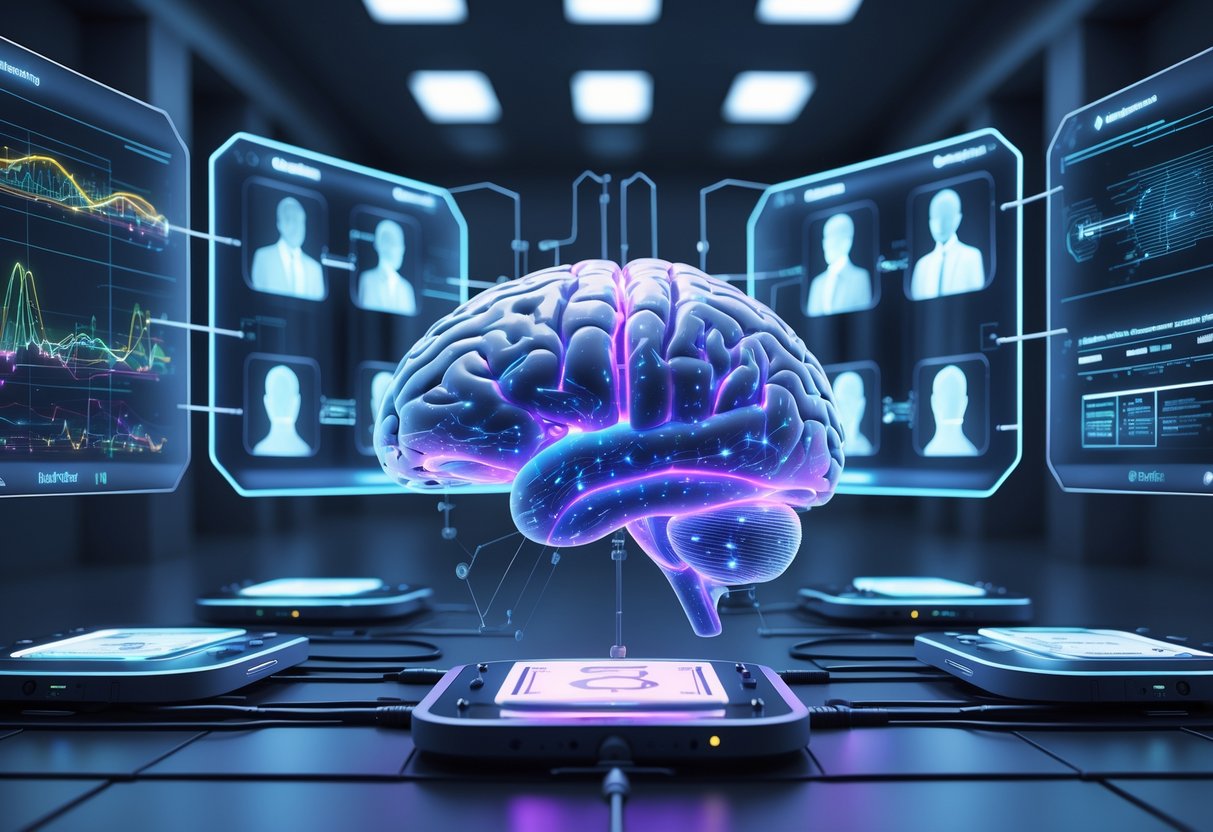
A handful of companies lead the way in brain-computer interface tech, each with their own take on connecting minds to machines. Neuralink pushes high-bandwidth neural threads, Precision Neuroscience develops ultra-thin brain chips, and Synchron goes for minimally invasive devices through blood vessels.
Neuralink
Neuralink has grabbed headlines with its bold plans for advanced neural implants. The company makes ultra-fine threads that connect straight to brain tissue using their N1 chip system.
They use thousands of flexible electrode threads, each thinner than a human hair. These threads cause less tissue damage than old-school brain chips. A surgical robot places the threads in just the right spots.
The N1 implant sits flush with the skull and sends brain signals wirelessly to outside devices—nothing sticking out. That makes it way more practical for daily life.
Neuralink has already shown paralyzed patients controlling computers just by thinking. People have typed messages and played games with nothing but brain signals. The company hopes to move beyond paralysis and tackle other brain disorders too.
Precision Neuroscience
Precision Neuroscience takes a different route with its Layer 7 Cortical Interface. Their implant is a thin film that rests on the brain’s surface, not deep inside.
This cuts surgical risks way down. The device is thinner than a hair and bends to fit the brain’s shape. No drilling holes or poking into brain tissue like before.
Their Layer 7 system goes in through a small skull opening, making it less invasive than other brain chips. The thin design also means less inflammation and scarring.
The company aims to help people with paralysis get back movement and communication. Their chips decode movement intentions from the motor cortex. Early trials have shown promising results for controlling devices by thought alone.
Synchron
Synchron’s taken a pretty unique route—you don’t need brain surgery at all. Their Stentrode device actually reaches the brain through blood vessels, so it’s the least invasive option out there.
Doctors insert the device through a blood vessel in the neck. It travels through the circulatory system until it gets to the motor areas of the brain. No skull surgery, no direct contact with brain tissue.
The Stentrode sits inside a blood vessel right by the motor cortex. It picks up brain signals through the vessel wall and sends them wirelessly to external devices. Patients can control computers, smartphones, and other tech just by thinking.
This less invasive method cuts down on surgical risks and shortens recovery time. Synchron already has regulatory approval in Australia and the US.
Their trials? People with severe paralysis have managed to control digital devices and regain some independence.
Clinical Applications of Brain-Computer Interfaces
Brain-computer interfaces are shaking up medical care by giving patients with severe disabilities a way to regain control over movement, speech, and daily life. These systems let the brain talk directly to external devices like robotic arms, wheelchairs, and speech computers.
Restoring Mobility
BCIs have opened up mobility solutions for people with spinal cord injuries and paralysis. Patients can now control robotic arms and prosthetic limbs with just their thoughts.
Recent clinical trials show real progress. Paralyzed patients have picked up objects, fed themselves, and handled daily tasks using robotic arms.
Key mobility applications include:
- Controlling prosthetic limbs for amputees
- Operating robotic arms for quadriplegic patients
People can also direct powered wheelchairs using brain signals or activate electrical stimulation systems.
The technology reads signals from the brain’s motor cortex—the same signals that would move arms and hands. BCIs translate those into commands for devices.
Right now, most systems need electrodes implanted surgically. Patients spend a lot of time training to get reliable control. Most setups are still experimental and not available on the market.
Assisting Speech and Communication
BCIs have made it possible for people with speech impairments to communicate more naturally. Folks with ALS or stroke damage often lose the ability to speak.
Traditional aids need some form of physical movement to select letters or words. BCIs skip that step.
Communication applications include:
- Turning intended speech into text on screens
- Generating synthetic speech from brain signals
- Moving a cursor for typing
- Running communication software without hands
Recent breakthroughs let some patients type at speeds of 90 characters per minute. That matches what most people do on a smartphone.
These systems decode signals from the brain’s speech areas. Even if someone can’t speak, the brain still produces speech-planning signals.
Accuracy and speed still need work. Most systems only handle limited vocabulary for now.
Treatment of Neurological Conditions
BCIs are starting to offer new treatment options for several neurological conditions—not just paralysis or speech disorders. Results look promising for lots of different issues.
Treatment areas include:
- Depression and treatment-resistant mental health conditions
- Epilepsy monitoring and seizure prediction
Stroke rehab and Parkinson’s symptom management also benefit.
For depression, BCIs can spot abnormal brain patterns. The system then delivers targeted stimulation to help restore normal brain function.
Epilepsy patients get continuous brain monitoring. BCIs can predict seizures minutes ahead, so patients can take medication before anything happens.
Stroke patients use BCIs for rehab. The tech helps retrain damaged brain circuits, giving real-time feedback during movement exercises.
Early clinical results point to better patient outcomes, but most treatments are still experimental and need more research and safety checks.
BCIs for Rehabilitation and Accessibility
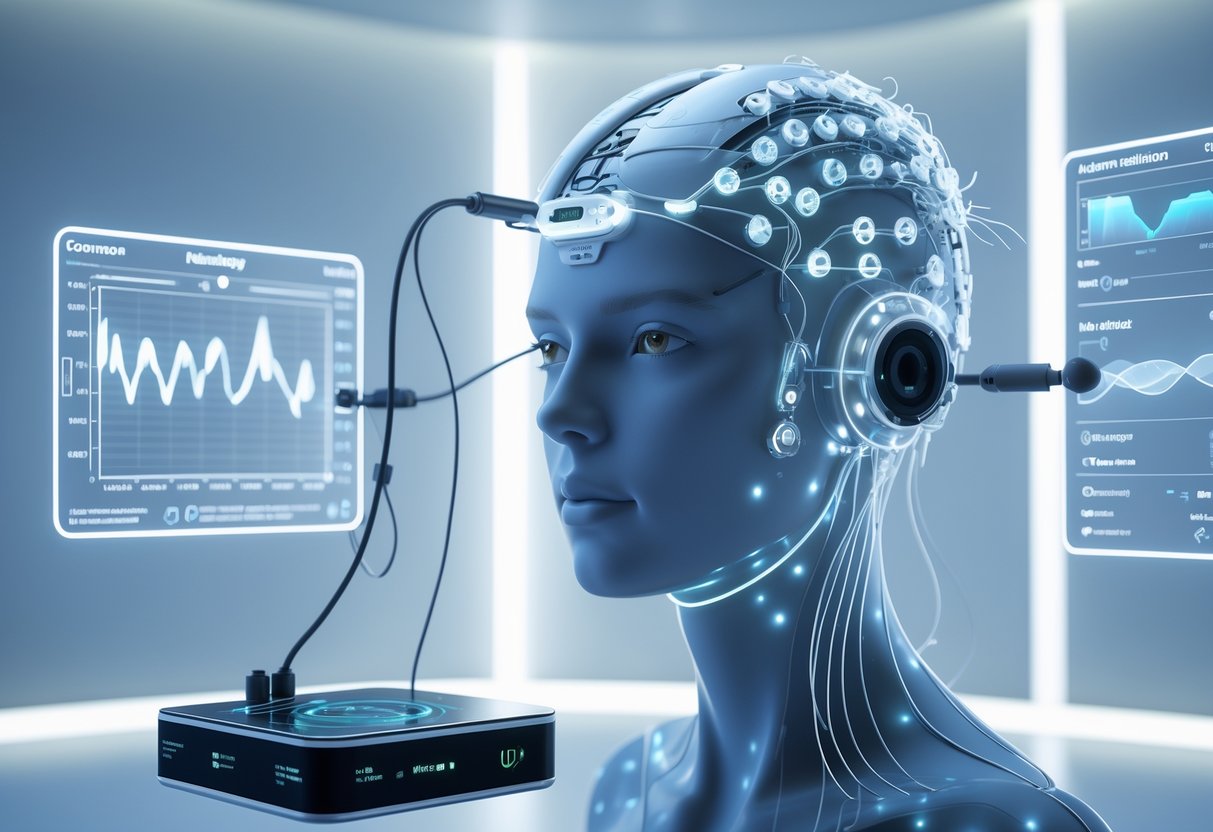
Brain-computer interfaces are changing lives for people with neurological conditions. They’re giving folks new ways to communicate and control their environments.
Patients with ALS get back some communication abilities. Paralyzed individuals can control devices just by thinking. Epilepsy management is also seeing improvements.
ALS and Amyotrophic Lateral Sclerosis
ALS patients gradually lose motor function but keep their cognitive abilities. BCIs become a lifeline for communication as the disease progresses.
Communication Solutions
- Typing systems: Patients use brain signals to move a cursor and type out messages.
- Speech synthesis: Advanced BCIs turn intended speech into artificial voice output.
- Eye-tracking integration: Some systems mix brain and eye signals for better accuracy.
The tech works best early in ALS, when patients can still train the system. Training usually takes 2–4 weeks of regular sessions.
Current Limitations
- Systems need frequent calibration.
- Battery life puts a limit on portability.
- High costs (£15,000–50,000) make access tough.
Research suggests BCI communication systems improve quality of life and cut down on isolation. People can stay involved at work and with family even when they can’t speak.
Support for Paralysis
Paralyzed patients find BCIs restore control over external devices—and sometimes even their own limbs.
Device Control Options
- Robotic arms: Patients move prosthetic limbs with their thoughts.
- Wheelchair navigation: Brain signals steer powered wheelchairs.
- Computer interaction: Direct cursor control allows independent computer use.
- Environmental controls: Smart home systems respond to brain commands.
Functional Electrical Stimulation Some BCIs can activate paralyzed muscles using electrical stimulation. When patients think about moving, the system stimulates the right muscles to make it happen.
Training needs vary a lot. Simple cursor control might take days to learn, but complex prosthetic control can take months.
Success Rates
- 80% of patients manage basic cursor control.
- 60% use robotic devices successfully.
- 40% master complex, multi-dimensional control.
The tech works best for spinal cord injuries if the brain’s motor areas are still intact.
Epilepsy and Other Disorders
BCIs are bringing new ideas to epilepsy and other neurological conditions where medication doesn’t always work.
Epilepsy Management
- Seizure prediction: EEG-based systems spot early seizure signs and alert patients.
- Responsive stimulation: Devices deliver targeted brain stimulation to stop seizures.
- Medication delivery: Closed-loop systems release drugs when needed.
The NeuroPace system, already approved for clinical use, cuts seizure frequency by 40–60% for patients who don’t respond to meds.
Other Neurological Conditions
- Stroke recovery: BCIs help retrain damaged brain areas through neurofeedback.
- Multiple sclerosis: Communication aids support patients with speech issues.
- Traumatic brain injury: Assessment tools help detect consciousness levels in unresponsive patients.
Treatment Outcomes
| Condition | Success Rate | Primary Benefit |
|---|---|---|
| Epilepsy | 60–70% | Fewer seizures |
| Stroke | 45–55% | Better motor function |
| MS | 70–80% | Improved communication |
These tools often work alongside traditional rehab for the best results.
Neuroscience Foundations
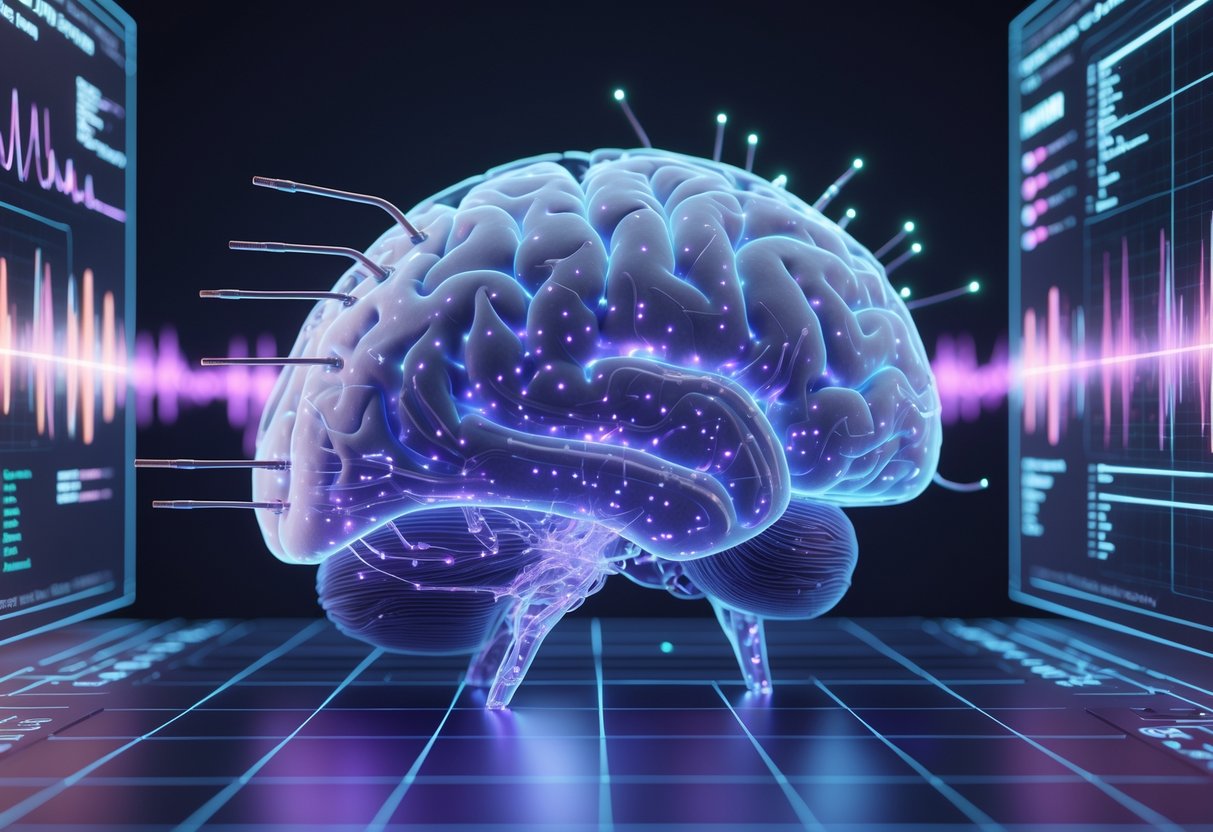
Brain-computer interfaces capture electrical activity from specific brain regions and turn those signals into commands for devices. The motor cortex fires off patterns of activity when we think about moving, and specialized electrodes pick up these signals, ranging from 1Hz to several thousand Hz.
Brain Regions and Cortical Mapping
The motor cortex is the main target for most BCIs. It sits along the precentral gyrus and controls voluntary movement.
Scientists use the motor homunculus to map the motor cortex. Different parts control different body areas—hands and face take up a lot of space, while the trunk uses less.
Key motor cortex regions include:
- Primary motor cortex (M1) – direct movement control
- Premotor cortex – movement planning
- Supplementary motor area – complex movement sequences
| Brain Region | Function | BCI Application |
|---|---|---|
| M1 | Direct motor control | Prosthetic limb control |
| Premotor | Movement planning | Cursor movement |
| Somatosensory | Touch feedback | Sensory restoration |
The cortex holds about 16 billion neurons in six layers. Each layer processes different info and connects to various brain regions.
Electrophysiological Mechanisms
Brain activity creates electrical signals when ions move across neuron membranes. When neurons fire, they send action potentials at speeds up to 120 meters per second.
Neuronal signals show up in different ways. Single neurons fire at 1–100Hz, while groups of neurons create bigger signals called local field potentials.
BCIs pick up these signals using:
- Single-unit activity – individual neuron spikes
- Multi-unit activity – small groups of neurons
- Local field potentials – bigger group signals
The cortical interface has to sort out these signal types. Thinking about moving right looks different in brain activity than thinking about moving left.
Signal quality depends on where you put the electrodes. Electrodes within 50–100 micrometers of neurons pick up the strongest signals.
Cortex and Motor Functions
Motor functions in the brain follow certain patterns. When we plan movement, the premotor cortex lights up first, then the primary motor cortex jumps in.
The cortex organizes movement using population vector algorithms. Groups of neurons work together, and their combined activity points in the direction we want to move.
Cortical interface systems decode these group signals. Modern BCIs analyze activity from 100–1000 neurons at once to figure out movement intentions.
Different movements have their own neural signatures:
- Reaching movements – smooth, directional patterns
- Grasping actions – complex, multi-finger coordination
- Imagined movements – similar, but weaker patterns
The motor cortex keeps these patterns even after spinal cord injury. This lets paralyzed people control robotic arms by just thinking about moving.
Motor functions change over time with BCI training. Users learn to adjust their brain signals, and the system learns their unique patterns.
Biofeedback and Neurofeedback Techniques
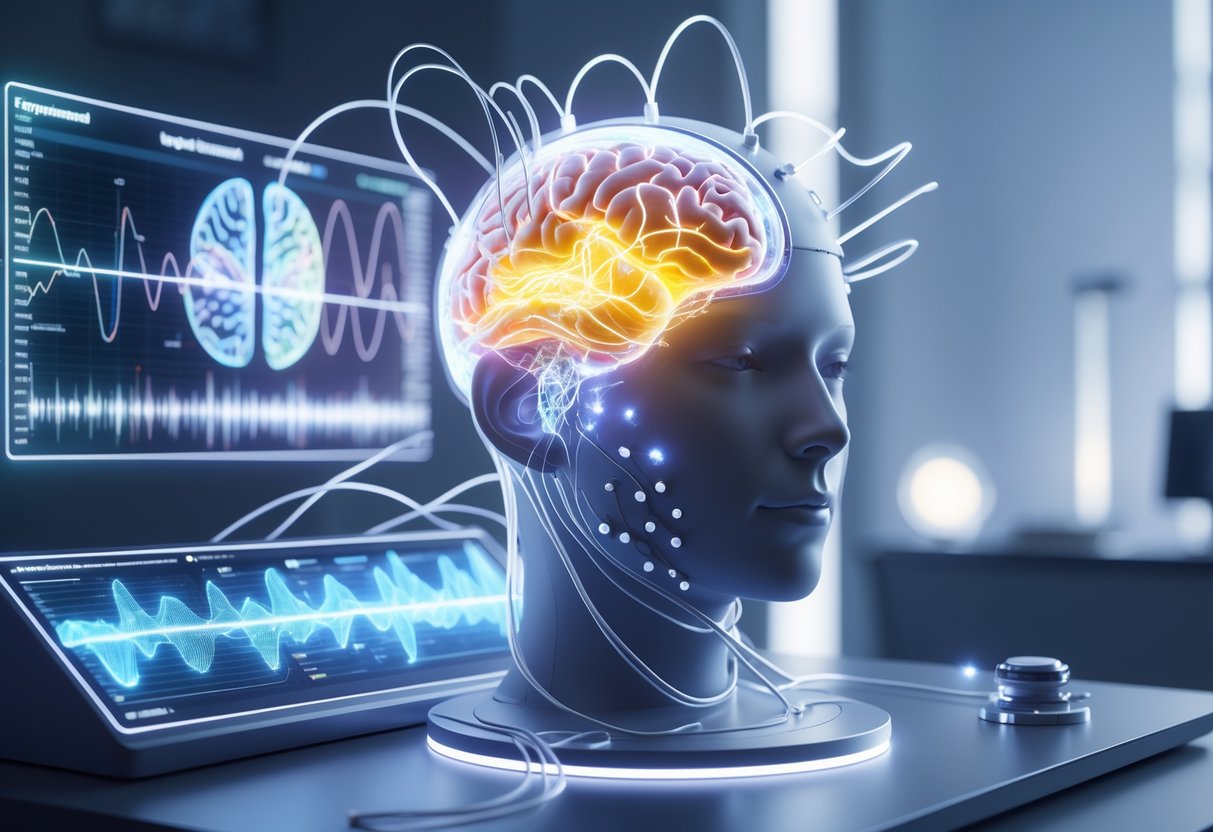
Biofeedback gives people real-time info about their body functions, while neurofeedback focuses on brain activity through operant conditioning. These techniques are showing real promise for depression and ADHD by teaching the brain to regulate itself.
Principles of Biofeedback
Biofeedback works by showing people what’s going on inside their bodies in real time. You might see your heart rate, muscle tension, or brain waves on a screen.
The brain learns with operant conditioning. If you hit the right brain pattern, you get a reward—maybe a sound or a visual cue.
Key components include:
- Real-time monitoring equipment
- Visual or audio feedback signals
A reward system helps reinforce correct responses. Training sessions need to happen regularly.
We can’t consciously feel our brain waves or blood flow. But with enough feedback sessions, people start to get a sense of these processes.
Most folks try different mental strategies during training. Some picture peaceful scenes, others focus on breathing or certain thoughts.
Neurofeedback for Mental Health
Neurofeedback targets brain wave patterns linked to mental health. We measure electrical activity with EEG electrodes placed on the scalp.
Common protocols focus on:
- Alpha waves (8–13 Hz) for relaxation
- Beta waves for attention and focus
- Theta waves for emotional regulation
Training usually takes 20–40 sessions over a few months. Each session lasts 30–60 minutes.
Modern neurofeedback sometimes teams up with brain-computer interfaces. These systems use advanced algorithms to give more precise feedback on brain states.
Research suggests neurofeedback can help regulate brain networks involved in mood and attention. The technique teaches self-regulation skills that stick around after training ends.
Training process:
- Measure baseline brain activity
- Identify target patterns
- Give real-time feedback during sessions
- Track progress over time
Applications in Depression and ADHD
Depression treatment aims to rebalance brain wave patterns. People with depression often show changes in alpha and theta activity in the frontal brain regions.
| Condition | Target Frequency | Sessions Needed | Success Rate |
|---|---|---|---|
| Depression | Alpha enhancement | 20-30 sessions | 60-70% |
| ADHD | Beta training | 30-40 sessions | 70-80% |
ADHD protocols usually boost beta waves and lower theta activity. This combo helps people focus better and dial down hyperactivity.
Kids often enjoy neurofeedback because it feels like a game. They steer characters or animations using just their brain activity.
Common improvements include:
- Better focus and attention span
- Less impulsivity
- Improved mood regulation
- Enhanced sleep quality
People often notice benefits for months after finishing training. Still, some need a refresher session here and there to keep the gains.
Neurofeedback works best when paired with other treatments. It’s a good idea to combine it with therapy, medication, or lifestyle tweaks for the best outcome.
Emerging Uses of BCIs Beyond Medicine
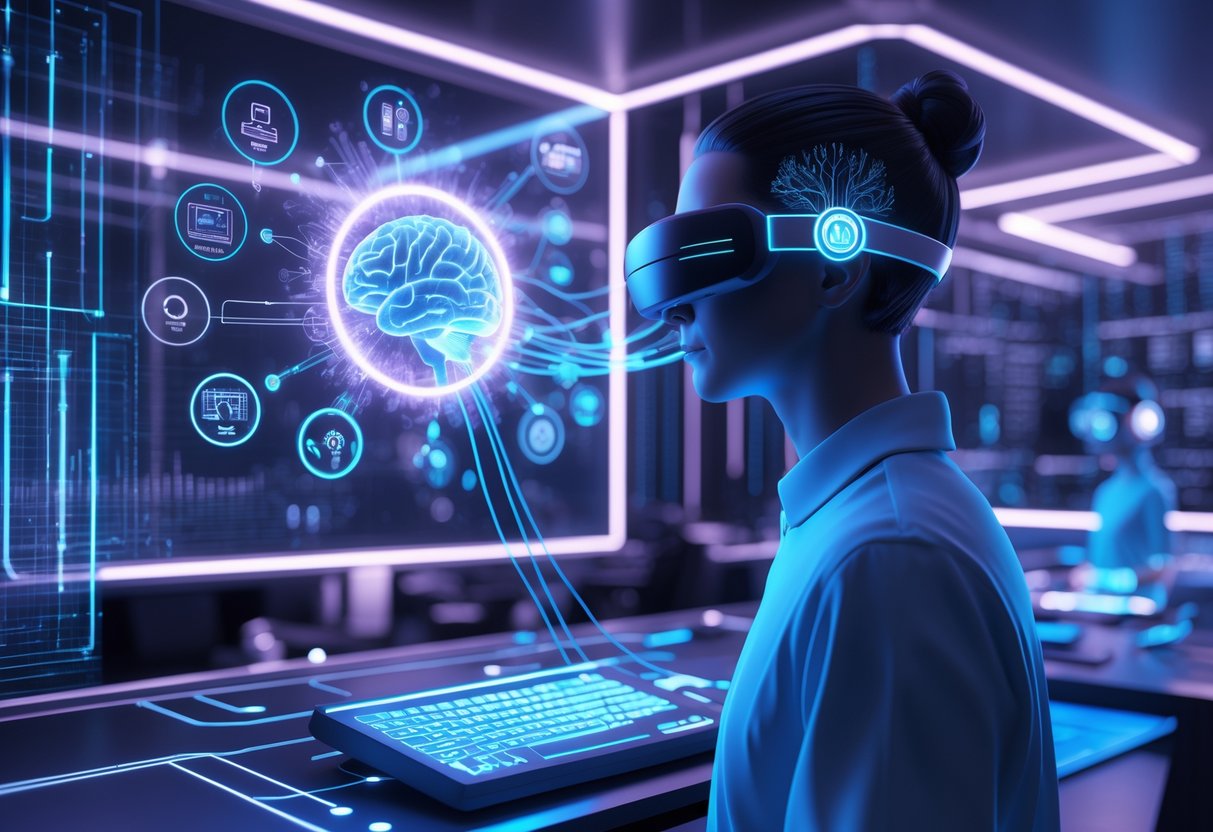
Brain-computer interfaces are moving far beyond medical rehab these days. Now, they’re popping up in entertainment and performance enhancement, focusing on immersive experiences and boosting how we think.
Augmented Reality and Gaming
Gaming companies want to make playing even more immersive than what controllers offer. Imagine steering a character with your thoughts instead of mashing buttons.
Today’s BCI gaming systems pick up on basic brain signals like how focused or emotional you feel. Games can change difficulty or tweak the virtual world on the fly.
Key gaming applications include:
- Thought-controlled character movement
- Emotional state detection for dynamic storylines
- Mental focus training through neurofeedback games
- Hands-free menu navigation
Early BCI gaming headsets run from £200 to £800. Most handle simple commands like “move forward” or “select item.”
But, honestly, complex movements still stump the tech. These systems can’t match the speed or precision of regular controllers in fast-paced games.
Augmented reality mixed with BCIs opens up new experiences. Users might control AR overlays with their minds, keeping their hands free for other stuff.
Enhancement of Cognitive Skills
Developers are working on BCIs to sharpen memory, focus, and learning speed—even for healthy folks. These gadgets stimulate certain brain regions or give feedback about mental states in real-time.
Neurofeedback training can help people concentrate and chill out. Wearing a BCI headset, users get audio or visual cues when they hit the right mental state.
Common cognitive enhancement targets:
- Memory formation and recall
- Sustained attention during work or study
- Creative problem-solving abilities
- Language learning speed
Research results are all over the map. Some studies find a 10-15% boost in working memory, but others see little lasting change.
Costs vary quite a bit:
- Basic neurofeedback devices: £100-£300
- Professional-grade systems: £1,000-£5,000
- Clinical training sessions: £50-£150 per hour
People still worry about safety with long-term use. Most consumer BCI devices haven’t been approved for cognitive enhancement claims.
These systems tend to work best for training attention and relaxation. When it comes to boosting creativity or intelligence, results are pretty limited.
Safety, Ethics, and Privacy in Brain-Computer Interfaces
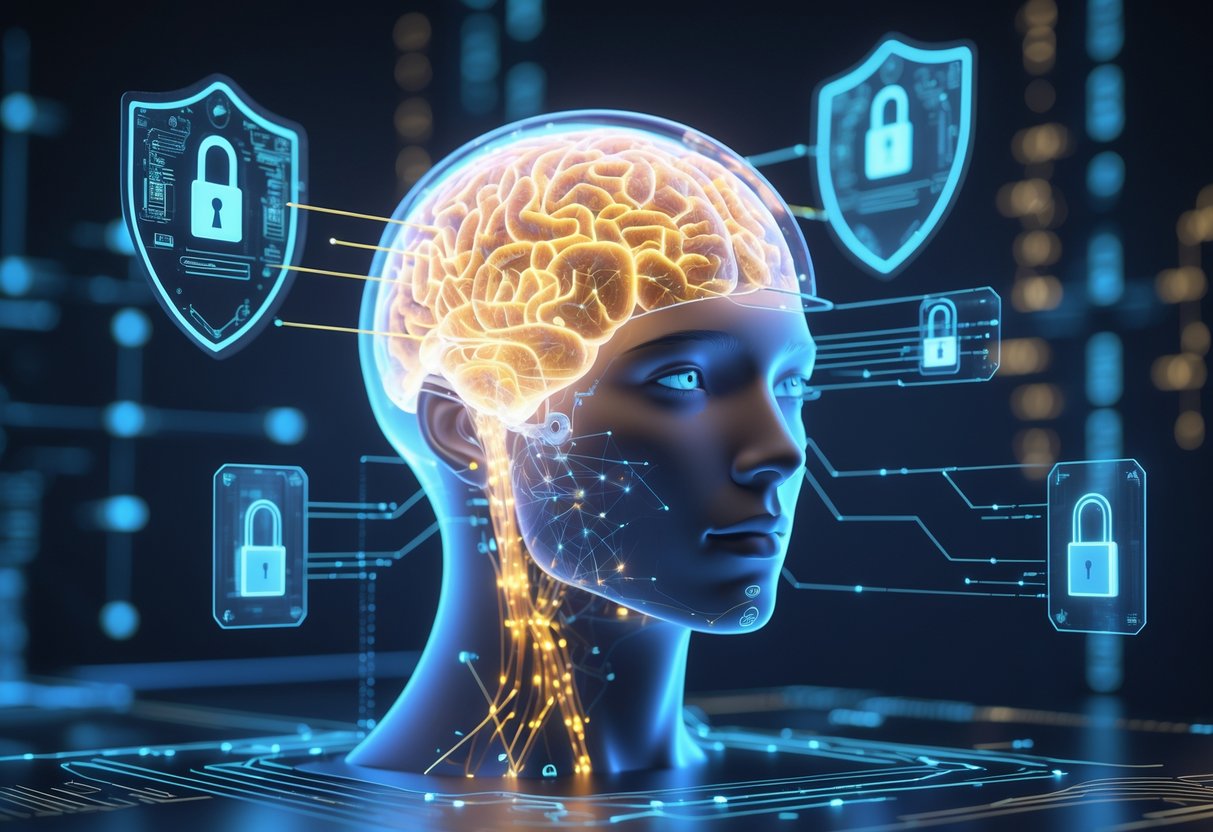
Brain-computer interfaces open up tough questions about protecting our most private data—our thoughts. People worry about getting proper consent, keeping brain data safe from hackers, and handling health risks from implants.
Consent and User Autonomy
Getting consent for brain-computer interfaces is trickier than with regular medical procedures. People need to understand that BCIs could tap into their thoughts, feelings, and how they think.
Many clinical trials now include long counselling sessions before anyone signs up. People have to know exactly what brain data will be collected and how it might get used later.
Things get even more complicated when BCIs are for enhancement, not medical treatment. Healthy users might not really get the long-term implications of having their brain activity monitored all the time.
Researchers have built new consent frameworks just for neurotech. These let users pull their consent at any time, even after getting a device implanted.
Some BCIs can even influence decisions, which raises the question—are users still really in control? It’s a weird twist: the tech that’s supposed to give people more power might actually take some away.
Brain Data Security
Neural data is about as personal as it gets. If someone hacks your brain patterns, you can’t just change them like a password.
BCIs pick up thousands of data points every second. This info could reveal health issues, moods, or even what you might do next—sometimes before you know it yourself.
Encryption matters a lot, but it’s not easy because BCIs need to process signals instantly. Standard security can slow things down, which is a problem for anything that needs to react fast.
Researchers are working on security just for neural interfaces. They’re trying things like:
- End-to-end encryption for all neural signals
- Secure authentication using brainwave patterns
- Data anonymisation to hide identities
- Local processing to cut down on data sent out
The biggest threat comes from people hacking into BCI systems. If that happens, someone could read your thoughts or send fake signals to mess with your environment.
Long-Term Implant Safety
Invasive BCIs need surgery to put electrodes right into the brain. Honestly, no one knows the long-term effects yet, since this tech is so new.
Clinical trials usually last a few years, but people might live with these implants for decades. We need way more data about how brain tissue reacts over time.
Common worries include:
- Infection risk from surgery
- Scarring around electrodes
- Device malfunction or battery problems
- Immune reactions to foreign materials
Some people have had complications that needed more surgeries. This just shows how important thorough testing is before these devices become mainstream.
Researchers are trying out biodegradable electrodes and wireless power to cut down on risks. If these work, BCIs might get safer for healthy folks who just want enhancements.
Doctors are starting regular checkups for implant users that last years. Tracking these people will help us really understand the safety of brain-computer interfaces.
Recent Advances and Future Directions
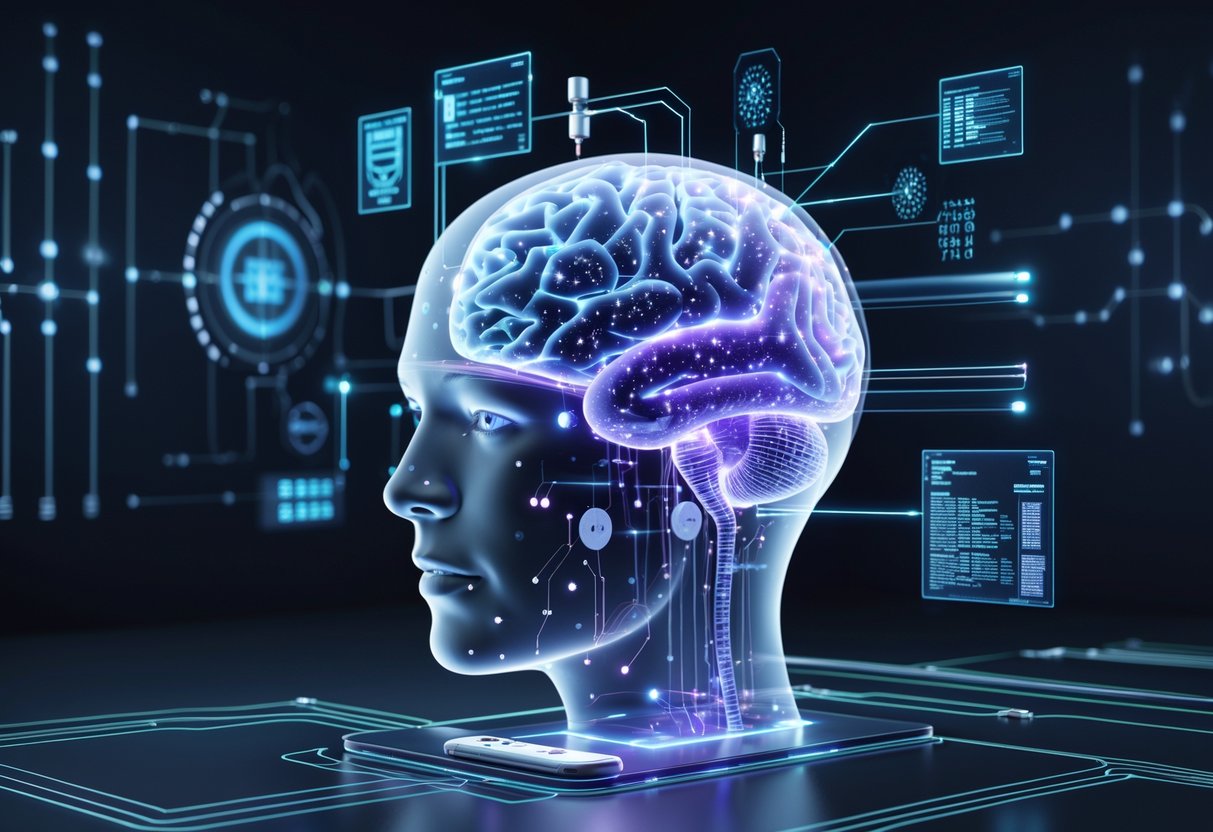
Brain-computer interfaces have changed a lot in just the past few years. Stanford Medicine recently managed to decode inner speech, and labs everywhere are now recording from thousands of neural sites at once. The tech now ranges from clinical trials helping paralysed people communicate to portable systems that regular folks might use soon.
Trends in BCI Research
Clinical trials are really pushing BCI technology forward. Stanford’s new study decoded inner speech in people who can’t talk, which could help those with ALS or strokes.
Researchers keep raising the bar. Modern neural interfaces now record from thousands of brain sites at the same time, with capacity doubling about every seven years—kind of like Moore’s Law, but for brains.
The spotlight is now on real-world uses. Studies in 2023-2024 focused on:
- Speech restoration for communication disorders
- Motor control for paralysis
- Mental health treatments for depression and ADHD
- Cognitive enhancement for autism spectrum conditions
Non-invasive EEG systems have come a long way. With better algorithms and denser electrodes, some now rival invasive systems—without the need for surgery.
Key Research Areas:
- Real-time language rehabilitation
- Motor recovery through neuroplasticity
- Closed-loop brain stimulation
- Home-based, personalised training
Frontiers in Neural Engineering
Neural implants keep getting smaller, safer, and more effective. Engineers have built direct-conversion front-ends that handle big interference while still picking up tiny brain signals. These systems now hit over 110 dB dynamic range, which is crucial outside the lab.
New ways to record brain activity are popping up. Functional ultrasound (fUS) offers a middle ground between invasive and non-invasive. Endovascular BCIs give precise readings without opening up the skull.
Hardware Improvements:
- Input impedance in the gigaohm range
- Common-mode rejection up to 140 dB
- Power use as low as 63 microWatts
- Electrode arrays with thousands of sites
Software is catching up fast. AI now helps decode complicated neuronal signal patterns. Machine learning adapts to each person’s brain, so setup gets quicker.
Bidirectional systems can now both record and stimulate. Deep brain stimulation treats Parkinson’s and tracks brain responses at the same time. This closed-loop approach tunes treatment as it happens.
Perspective on Everyday Adoption
Consumer BCI systems are getting close to reality. Dry electrodes mean no more messy gels, which makes home use way easier. Portable designs let people get treatment outside hospitals.
Barriers like cost, complexity, and training still slow things down. But, honestly, it feels a lot like the early days of mobile phones—expensive and awkward at first, then suddenly everywhere.
Adoption Timeline:
- 2025-2027: More medical applications
- 2028-2030: Assistive devices for disabilities
- 2030+: Consumer products hit the market
Privacy is still a big worry. Brain data is super personal, and we’ll need new rules to protect it as the tech spreads.
Competition is heating up. Companies are racing to connect brains and machines, which speeds up innovation. In the end, this helps patients and regular users get better tech faster.
We’ll probably see three big waves of adoption. First, people with serious medical needs. Second, assistive tech for daily disabilities. Last, enhancement tools for healthy folks who want a mental edge.
Frequently Asked Questions
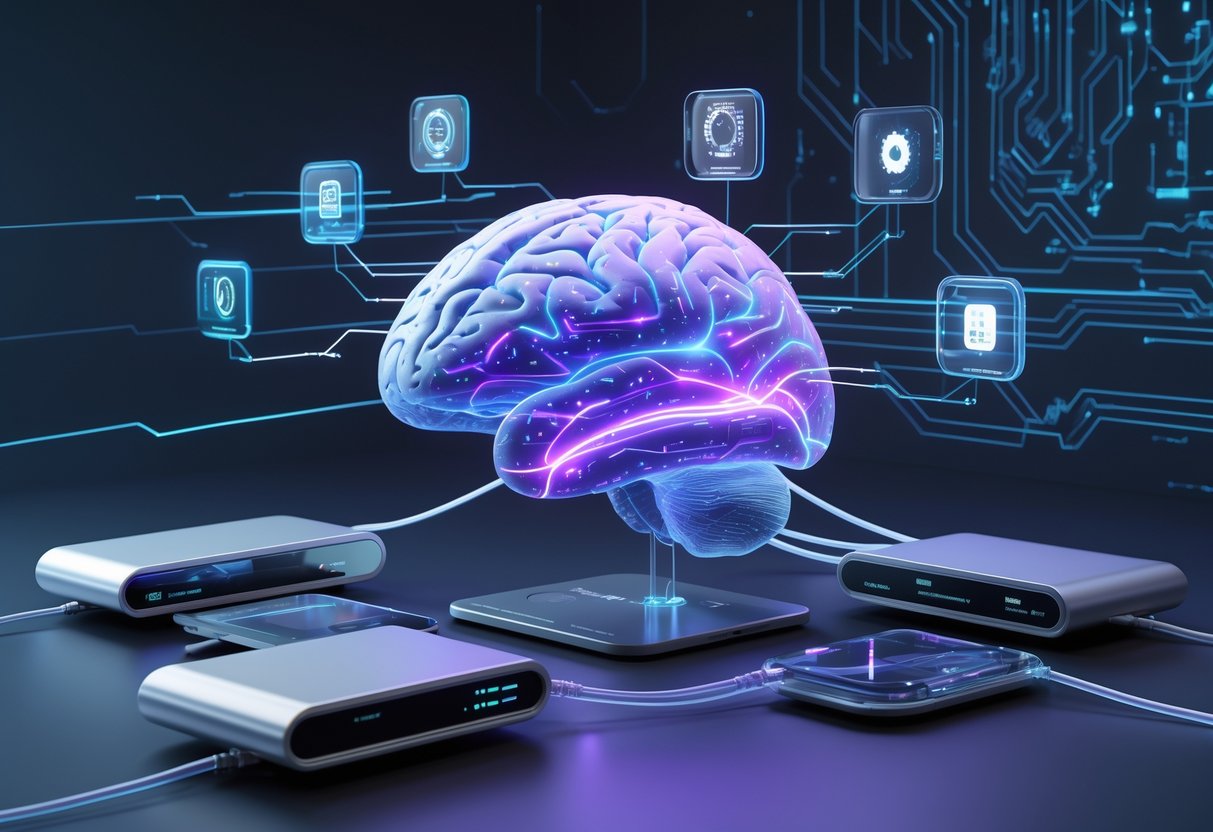
Brain-computer interfaces bring up a lot of questions about safety, uses, and what’s actually out there now. Here are some answers about real-world applications, leading companies, and the research shaping this field.
What potential applications do brain-computer interfaces have within various industries?
Healthcare leads the way for BCI use. Devices help paralysed people control robotic limbs and wheelchairs. Now, people with spinal cord injuries can move prosthetics just by thinking about it.
Non-verbal individuals use BCIs for communication through “mindwriting” systems. Stanford researchers hit 62 words per minute with their brain chip—about as fast as talking.
Gaming and entertainment companies are testing non-invasive headsets for controlling virtual worlds. Players could move through games or VR spaces using just their minds.
Smart homes are getting in on the action too. People can control lights, TVs, and more with mental commands—especially helpful for those with mobility challenges.
The military is exploring hands-free drone control. The Department of Defence is funding research into “telepathic” drone swarms.
Mental health treatment is another big area. BCIs might help with depression, anxiety, and OCD by targeting brain stimulation.
How do current brain-computer interfaces function, and what devices are available?
BCIs pick up electrical signals between neurons using electrode sensors. Machine learning then translates this brain activity into digital commands.
There are two main types: invasive and non-invasive. Invasive BCIs need surgery but get clearer signals since they connect right to the brain.
Non-invasive devices sit on the scalp. They’re safer but pick up weaker signals, so they’re better for gaming, AR, and basic controls.
Where you place electrodes affects signal quality. Devices closer to neural networks get “high definition” signals that translate more accurately.
Neural decoding software turns all that brain data into commands in real-time. This lets people control devices instantly.
Could you share some examples of brain-computer interfaces being implemented in real-life scenarios?
Neuralink implanted chips in three patients as of May 2025. Their first quadriplegic patient now controls computers with just their thoughts.
Synchron put devices in 10 patients using blood vessels via the jugular vein. These patients control computers and mobile devices in real-time.
Stanford’s brain chip let a non-verbal ALS patient communicate at 62 words per minute, using a 125,000-word vocabulary.
A January 2025 study had a tetraplegic patient fly a virtual quadcopter with a BCI. That shows real promise for drone control.
Blackrock Neurotech has tested devices in people since 2004. Their patients regained touch and control over prosthetics and digital devices.
Precision Neuroscience ran trials at Penn Medicine and Mount Sinai. Their thin-film electrodes help map brains during surgery.
Which companies are at the forefront of developing brain-computer interface technology?
Neuralink stands out, thanks to Elon Musk’s coin-sized surgical implant with micron-scale electrode wires. The team got FDA approval and already implanted three patients.
Paradromics goes head-to-head with Neuralink, using 420 micro-needle electrodes. Their Connexus device made it into its first human patient in May 2025.
Neurable takes a different approach with non-invasive headphones that read brain signals to boost productivity. Their Enten and MW75 Neuro models target everyday users.
Precision Neuroscience offers reversible brain films, thinner than a strand of hair. They snagged the first full FDA clearance for wireless BCI tech in April 2025.
Synchron skips brain surgery by inserting their device through blood vessels. They’re teaming up with OpenAI and Nvidia to give patients more options.
Blackrock Neurotech brings serious experience to the table, testing on humans since 2004. Their tools help people regain lost functions.
What are some of the latest discoveries in brain-computer interface research?
Precision Neuroscience hit a huge milestone with the first full FDA clearance for wireless BCI in April 2025. Now, commercial BCI tech seems a lot closer.
Researchers found that BCIs can restore natural conversation speeds, hitting 62 words per minute. That’s right up there with how people usually talk.
Scientists learned that graphene chips send stronger signals than old-school metal electrodes. Inbrain Neuroelectronics put this to the test on humans in 2024.
Some studies show BCIs can help people move their own paralyzed limbs again, not just prosthetics. This could mean bypassing spinal cord injuries entirely.
Early mental health trials hint that targeted brain stimulation might treat depression, anxiety, and even bipolar disorder. Mood regulation through BCIs? It’s starting to look possible.
Brain training with real-time biofeedback boosts memory, processing speed, and executive function. Users get to watch and improve their own cognitive skills on the spot.
What kinds of projects are currently underway to advance the field of brain-computer interfaces?
Clinical trials keep popping up at big medical centers like Penn Medicine and Mount Sinai Health System. Doctors and researchers use these studies to see how safe and effective BCIs really are for actual patients.
The BCI market looks set to jump from £1.6 billion in 2023 to around £5 billion by 2030. That kind of money really pushes research forward, not just for medicine but for all sorts of consumer tech too.
Military teams have started building hands-free control systems. Imagine soldiers operating drones, comms, or even navigation tools—just by thinking about it.
On the consumer side, tech companies are working on things like productivity headphones and gaming gear. They want BCIs to become as normal as smartphones, which honestly sounds wild, but maybe not impossible.
Some scientists are already thinking way ahead. They’re dreaming up BCIs that could boost human cognition beyond what’s possible now—extra brainpower, not just fixing what’s broken.
And of course, safety matters a lot. Researchers focus on lowering infection risks and tissue damage from implants. They keep looking for ways to make surgery safer and get the best possible signals from the brain.

